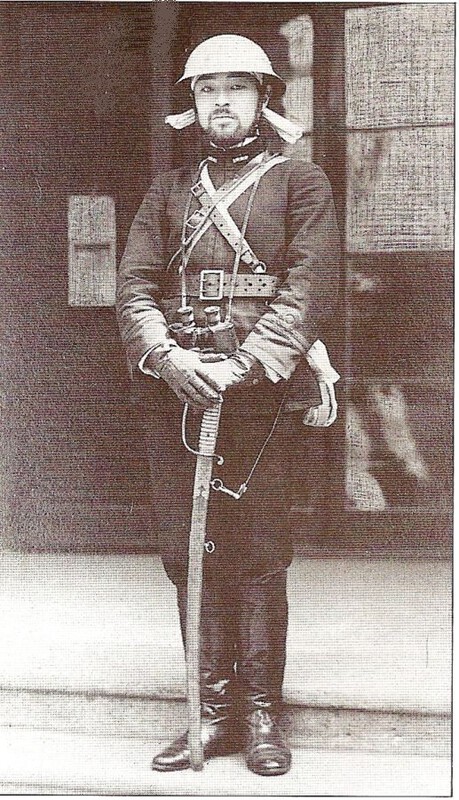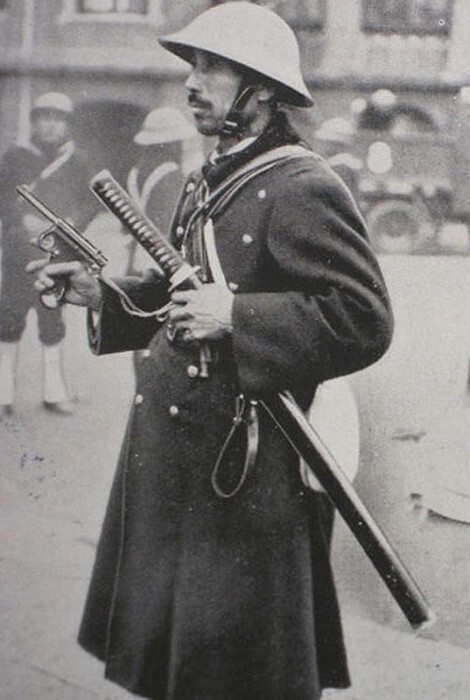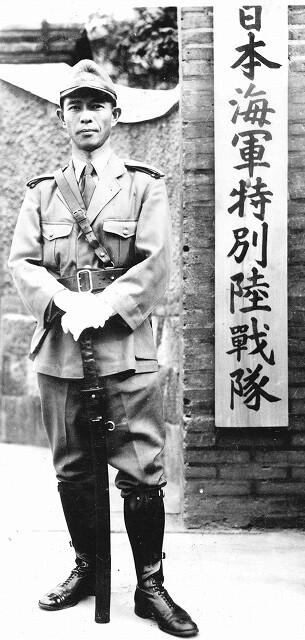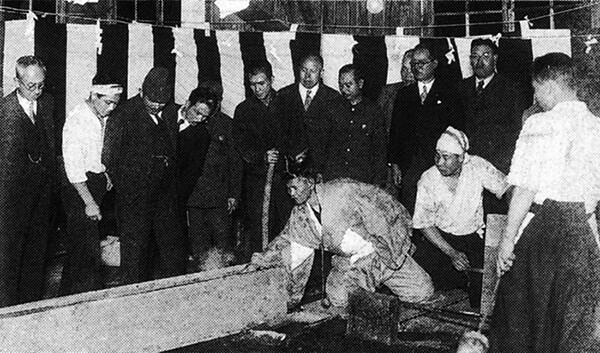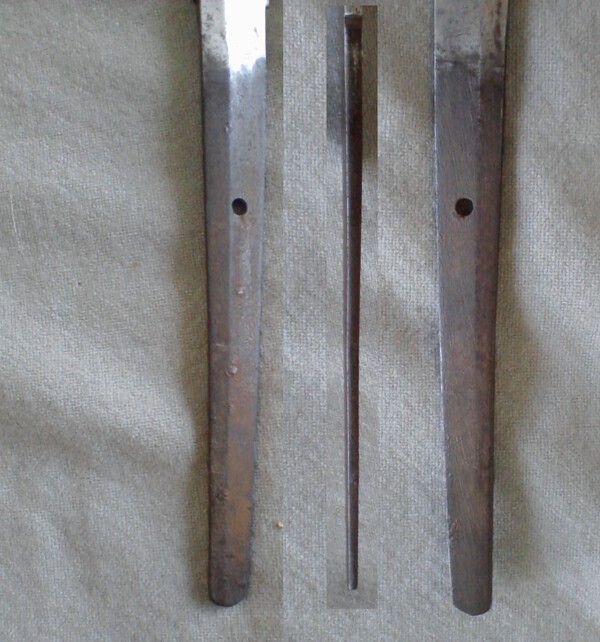-
Posts
1,691 -
Joined
-
Last visited
-
Days Won
11
Content Type
Profiles
Forums
Events
Store
Downloads
Gallery
Everything posted by Dave R
-
Pretty much my thinking as well. I have also seen sword belts of the period adapted to carry a conventionally mounted gunto in that same position.
-
The man carrying it!
-
When I became interested in "Gunto" I created a set of files of a) every variation I found of sword identified as carried by the IJA, and b ) every photo' I could find of IJA and IJN forces carrying swords. There are some interesting revelations within these. Regarding the haiken in the last pic', it is so far the only example I have found that I can confidently say is a WW2 sword with this feature..... but time may reveal others.
-
I think we will never be able to pin down an exact type for the landing forces per se. Photographs show such a wide variety in use, that I suspect that the officers carried what they thought fit. Another matter perhaps when it came to parades and formal occasions. Looking at photo's of the SNLF uniform and equipment is very varied... Of interest, in the last photo, the haiken looks to be on the ha side of the saya, rather than the mune!
-

katana Need Help Identifying Blade And Sword
Dave R replied to hbaubele's topic in Military Swords of Japan
Regarding nakago, a Japanese smith sees the nakago as having the same importance as the blade, and makes it as a continuation of such. He knows that normal maintenance will reveal it regularly, and it's where he places his signature. With a Showato factory blade the tang is made in one with the blade, often with rollers, and then the machi cut or ground, and the nakago finished so the habaki slides over it easily to a snug fit. With an osuriage the nakago is literally part of the original blade. The nakagojiri is one of the marks of his lineage or school, as is the yasurime,.... (which I think possibly also helps it grip the tsuka). A Chinese or even Western smith sees the tang as the bit hidden by the grip, never to be seen again, and puts as much work into it as it will need in such a situation. With a lot of earlier Western blades, the tang is even a separate welded on piece, and of a lower grade metal. A lot of veteran "bringbacks" were made by Allied forces engineers to sell to American servicemen who arrived too late to pick them up from the battle field. The Australian army were downright notorious for doing this, and I suspect that this is the origin of most "Island Swords". With the Ito, the overlaps alternate so that if one strand is cut, it will not unravel but will be held at the next overlap. It's a working feature, not decorative. There are lots of articles about these features scattered through the Shin-Gunto posts, on a number of militaria forums.I have posted nothing original here. (Apologies if this looks a bit ranty, or holding forth it's not meant to). -

katana Need Help Identifying Blade And Sword
Dave R replied to hbaubele's topic in Military Swords of Japan
In the end, it's all about the blade, and that nakago is not good. A definite wobble in the ridge line where the shinogi runs into the tang. Something you never see on even a cheap factory made blade, but common on the Chinese fakes. -

katana Need Help Identifying Blade And Sword
Dave R replied to hbaubele's topic in Military Swords of Japan
Frankly, it never occurred to me that anyone would think it worth putting original mounts on a fake blade, but this looks to be the case here. I suppose it makes a sort of sense given what even a half way decent Gunto fetches on the market nowadays. -
It looks like a standard army tassel for a Shin-Gunto.
-
Most of these (not all) are tourist pieces. As I understand it, the origin is with Village Headman swords, owned, worn, as a sign of authority, but rapidly degenerated down to tourist pieces after the Bakumatsu.
-
This is about the difference between a collectable item, and a museum piece. The one is for personal pleasure, and the other for research and learning.
-
I don't think they are being nice..... I think they might be dodging some point of their own laws about either forgery, or even promoting the Japanese Empire.
-
I see so many odd little faults in the Chinese replicas, that sometimes, just sometimes I wonder if they are deliberate.
-
Very much what you would see as a remounted Shin-Shinto blade in Gunto mounts. Being unsigned it would have been less expensive, but still a decent traditional blade. Another example of such is discussed here. http://www.warrelics.eu/forum/Japanese-militaria/documentation-came-shin-gunto-661009/ A lot of blades are Mumei, and there is a lot of discussion as to why. I have 10 Wakizashi and Katana, and only one of them, the Kaneyoshi Gendai is signed.
-
Without paperwork, or other authentication....
-
Not always. Some of them turn up on Showato. I think there is a bit of customisation going on, as in "posing". And for some of them a preference for a practical iron guard that would not be cut through by a Chinese Da Dao in combat.
-
-
Especially common on the leather covered wooden saya type, and not that rare on the metal saya either.
-
Regarding the lack of stamps etc. Here's one I bought earlier, definitely a "factory" made blade in homogeneous steel. Some "factories" were more like a small workshop, like the Sheffield "little mesters" who made cutlery and surgical tools til recently.
-
A perfectly decent Shin Gunto. Factory made blade, no stamps or signature and so probably non traditional, most likely oil tempered tool steel. I would be perfectly happy with one like it, nothing to complain about there at all.
-
Interesting and relevant article here..... .http://www.nihontocraft.com/Suishinshi_Masahide.html
-
A little relic of their original leader..... A little preparation, a little "edge" never comes amiss!
-
I would hardly call the Shinsengumi "special police", more like paramilitaries or even a political gang. Their leader Kondo Isami was eventually executed for murder.
-
Thinking further, I wonder if the saya was so damaged that the blade was jammed, which would also explain the way the Shin-Gunto is displayed in the case.... Partially drawn as far out of the Saya as it goes.
-
I suspect an already damaged (undergoing repair?) saya, held in the left hand... Which would explain why the blow was struck without drawing. If it had been belt hung that could not have happened/



